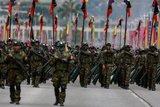Northrop Grumman's E-2D Advanced Hawkeye completes first carrier landing
The Northrop Grumman Corporation-built E-2D Advanced Hawkeye, the US Navy's newest airborne early warning and command and control aircraft, has landed on the USS Harry S. Truman (CVN 75) and begun carrier suitability testing.
With 99 percent of radar testing complete, the purpose of this phase of testing is to assess the aircraft's effectiveness in an operational environment. While onboard the Truman, all aspects of aviation/ship integration will be addressed, including logistics, manpower and interoperability, as well as catapult and arrested landing structural tests.
"This first landing of an E-2D Advanced Hawkeye on a carrier deck is a very proud moment for the entire Hawkeye team," said Jim Culmo, vice president, Airborne Early Warning & Battle Management Command and Control Programs, Northrop Grumman. "We're one step closer to delivering this revolutionary weapon system to the warfighter, a milestone the team has been working towards since Delta One took to the skies for the first time in August 2007. As the Navy kicks off its Centennial of Naval Aviation next week, Northrop Grumman continues to be committed to providing this critical first line of defense well into the 21st century."
Led by US Navy Air Test and Evaluation Squadron 20 (VX-20), testing is being conducted by an integrated test team consisting of Northrop Grumman and Navy pilots and maintainers. The aircraft that made the first carrier landing is "Delta One," the first E-2D Advanced Hawkeye to roll off Northrop Grumman's manufacturing line in St. Augustine, Fla.
The new aircraft will be able to scan a larger area, detect smaller objects and process information more quickly than its predecessor. The aircrews will be able to accomplish these tasks through improved all-glass cockpits and tactical operator stations.
"This new platform features state-of-the-art radar with a two-generation leap in capability and upgraded aircraft systems," said US Navy Capt. Shane Gahagan, Hawkeye, Advanced Hawkeye and Greyhound Program Office. "The E-2D continues the Navy's integrated war fighting legacy by providing broad area coverage resulting in increased range capabilities. With the E-2D's enhanced ability to work in the littoral areas and over land, the platform provides a critical capability to protect our nation's interests."
Source: Northrop Grumman
More from Digital Battlespace
-
![Babcock nears first customer for Nomad AI translation tool]()
Babcock nears first customer for Nomad AI translation tool
Nomad can provide militaries with real-time intelligence, saving critical time on the battlefield.
-
![AUSA 2025: Israel’s Asio Technologies to supply hundreds of improved Taurus tactical systems]()
AUSA 2025: Israel’s Asio Technologies to supply hundreds of improved Taurus tactical systems
Taurus operates alongside the Israel Defense Forces’ Orion system which supports mission management across tens of thousands of manoeuvring forces, from squad leaders to battalion commanders.
-
![AUSA 2025: Kopin pushes micro-LED plans as China moves faster]()
AUSA 2025: Kopin pushes micro-LED plans as China moves faster
The plan for the new displays follows fresh investment in Kopin’s European facilities by Theon and an order for head-up displays in fielded aircraft, with funding from the US Department of Defense.
-
![AUSA 2025: Persistent Systems to complete its largest order by year’s end]()
AUSA 2025: Persistent Systems to complete its largest order by year’s end
Persistent Systems received its largest ever single order for its MPU5 devices and other systems earlier this month and has already delivered the 50 units to the US Army’s 4th Infantry Division.
-
![Aselsan brings in dozens of companies and systems under the Steel Dome umbrella]()
Aselsan brings in dozens of companies and systems under the Steel Dome umbrella
Turkey has joined the family of countries attempting to establish a multilayered air defence system with government approval in August 2024 for the effort landed by Aselsan. Dubbed Steel Dome, the programme joins Israel’s Iron Dome, the US Golden Dome, India’s Mission Sudarshan Chakra and South Korea’s low-altitude missile defence system.
-
![DSEI 2025: MARSS unveils new agnostic multidomain C4 system]()
DSEI 2025: MARSS unveils new agnostic multidomain C4 system
MARSS’ NiDAR system has been deployed using sensors from static platforms to provide detection and protection for static sights, such as critical infrastructure, ports and military bases.



























